Crossbar lock: what is it, device and installation
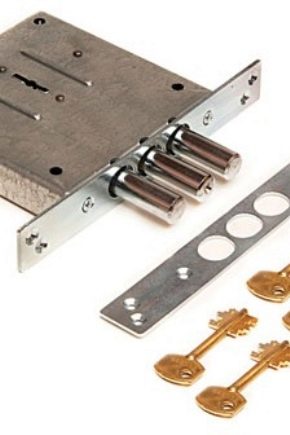
The security of a door lock has always been a hot topic along with a robust door. Thanks to modern technology, not every door can succumb to intruders, but it is much easier for them to open the lock mechanism.
Some of the most popular security locks are crossbar door locks. Despite the fact that they do not differ in a high level of protection, they are nevertheless excellent for some doors and are actively used.
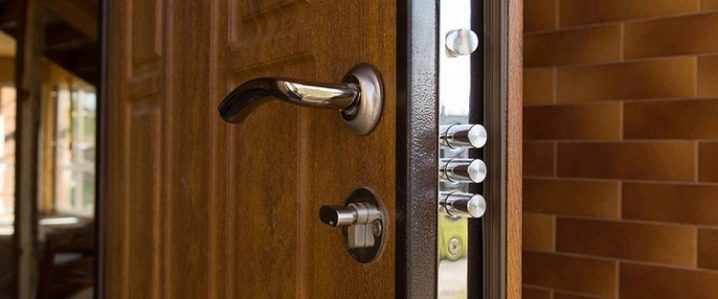
Mechanism
The crossbar is a part of the lock, which is a movable metal rod that can move between fixed elements. The design of the crossbar lock is based on just such rods. With the turn of the key, the deadbolt moves between other parts and is fixed in the desired position.
Similar mechanisms were previously used only to protect safes, but now, due to the increased demand for the production of more reliable mechanisms, they are used both for ordinary entrance doors and for utility doors and garages.
As a rule, complex transom mechanisms are installed only by professionals because of their complex design. Simpler models can be installed independently. An important point - during installation, you need to correctly calculate the number of inserted rods.

Common types
Crossbar locks are divided into several types according to their main characteristics: installation method, material of manufacture, appearance and even the level of complexity of the mechanism. But there are only two main types by design type.
Padlocks
Such models are very common - they are used as locks for lockers in some fitness clubs, for locking utility rooms or garages. Despite the aforementioned reliability of transom locks, this type does not differ in this characteristic, they are quite easy to open or hack, but only if you have special skills.
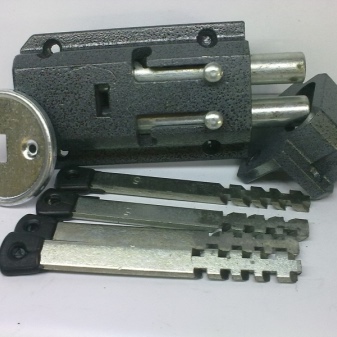
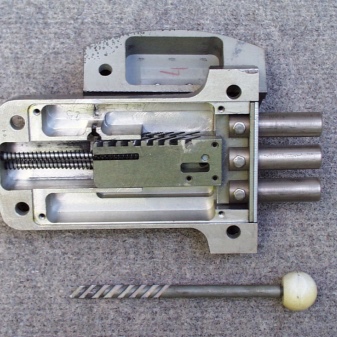
Mortise crossbar locks
The name of the castle itself suggests that it will not stand out too much on the surface of doors or gates.
Most often it is installed on armored entrance doors, does not "stick out" from the door surface.
Differs in a high level of reliability thanks to the so-called crab system. Fastening rods are installed around the entire perimeter of the lock and mounted directly into the door, which makes them resistant to burglary.


How to choose?
The material for making the lock must match the material from which the door is made. The market of locks provides an opportunity to choose a wide variety of models - from cast iron locks to stainless steel "guards". Of course, the last option is the most durable and has a long service life.
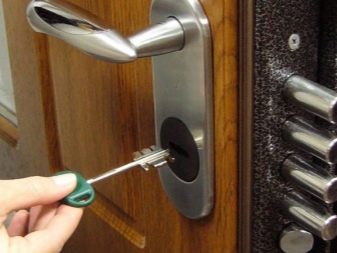

There are several characteristics by which you can test the strength of the lock transom mechanisms right before buying.
- As a rule, building supermarkets have several doors with similar "guards" installed on them. You need to take a closer look at such a door and check if it is wobbling. The door must be stationary when closed.
- The lock should have a minimum gap with the box, but it is better that it is completely absent. Otherwise, it will be very easy to hack.
- Such a mechanism must be made of hard, stiff, impact-resistant metal that can withstand heavy loads. This can also be verified upon purchase by placing a few heavy parts on the lock body.The main thing is not to overdo it and stick to reasonable boundaries.
Modern manufacturers offer a large number of models of crossbar locks, differing in quality, level of reliability, material of manufacture and dimensions. The choice of buying such a mechanism depends only on financial capabilities.
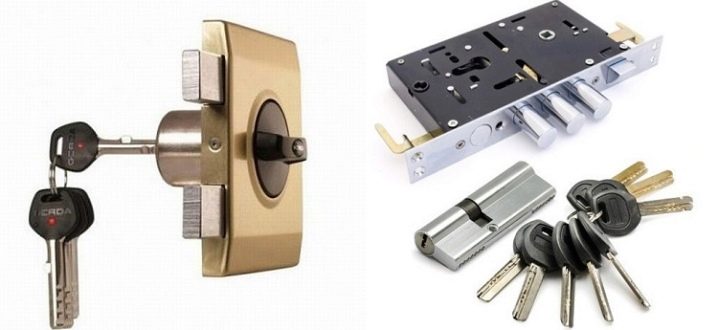
Mounting
Despite the fact that it was said above about the difficulty of installing crossbar locks, it is possible to do it yourself. But you can only install a hinged transom mechanism with your own hands. First of all, you need to protect your eyes. This requires special protective goggles. And you will also need a few special tools if you have experience with some of them.
These are the following:
- Bulgarian;
- pliers and screwdrivers;
- welding machine;
- drill and drill to it.
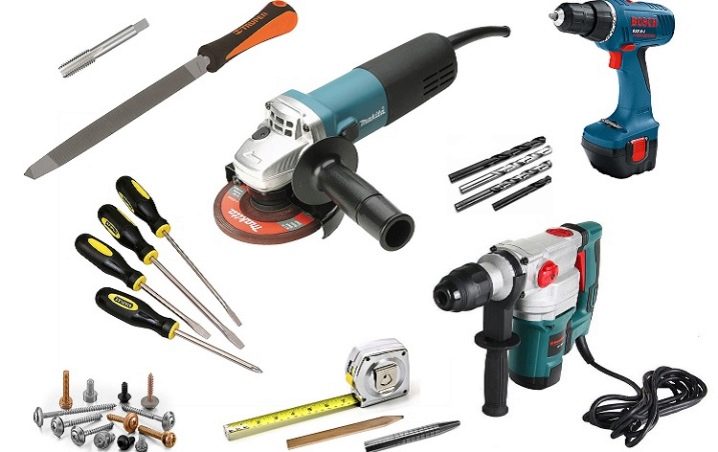
Below is a brief instruction on the installation of such locks.
- Outline the location of the mechanism. It is very important to correctly calculate the height of the lock installation and the distance from the edge. It should be roughly at a level just below the waist of the average person.
- Attach a mechanism to the door in order to mark the drilling points.
- Next, make markings at the end. In this case, it is important to take into account the thickness of the installed mechanism.
- Using a drill, drill holes along the edges of the end. It is precisely the correctly drilled holes that guarantee the firmness of the "fit" of the locking mechanism.
- Place the body on the door for marking.
- Bolt.
- Install the keyhole.
- The second part of the door lock is installed in the same way.
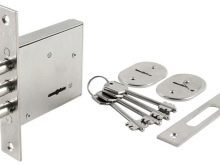
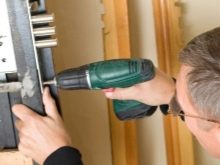
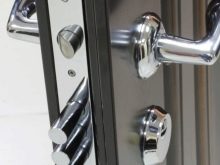
Advantages and disadvantages
Such locks owe their popularity for a long time to their positive qualities.
- Some models are easy to install on your own (especially for locks for small lockers, warehouses with not particularly valuable things), although, of course, it is better to seek help from a professional if you really want a reliable installation.
- They are easy enough to use. From the inside, such a mechanism snaps into place without using a key. It is enough just to slam the door.
- Affordable price. Such locking mechanisms never have too high a price, therefore they are available to almost everyone.
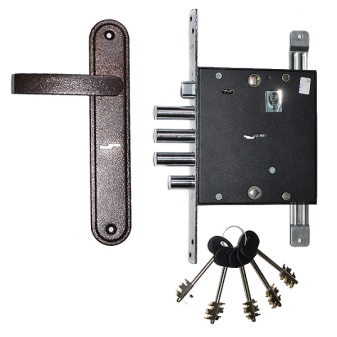
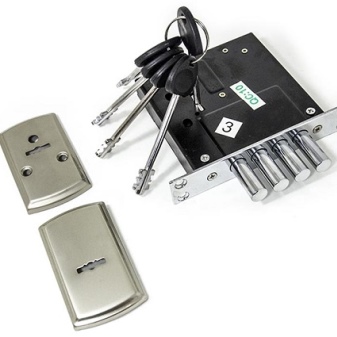
There are not so many design disadvantages.
- Low level of protection for some models. If you have the skills, it can be easily opened with a screwdriver / hairpin / nail / knife. With the help of these tools, the plates are pushed back. Moreover, they are easy to crack.
- The installation of the crossbar locking mechanisms is different from the installation of other models, so when replacing it you will have to add yourself a little more work, restoring the surface of the door and drilling new holes.
It is worth noting that due to the rapid development of technology over the past two centuries, the modern market is replete with various locking systems. The crossbar lock gives way in terms of reliability to some of its other "brothers" and is most often now used as an additional lock to the main one.
For information on how the crossbar lock works, see the next video.













The comment was sent successfully.